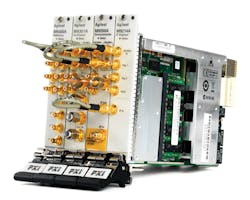Modular VSA Scans 160 MHz Through 6 GHz
Modular test instruments in the PXI and PXI Express (PXIe) format provide a great deal of measurement power in small packages. One of the latest PXIe instruments from Agilent Technologies, the model M9391A vector signal analyzer (VSA), provides as much as 160-MHz analysis bandwidth in versions from 1 MHz to 3 GHz or 1 MHz to 6 GHz. When combined with the company’s other X-series modular instruments—such as vector signal generators (VSGs)—a complete measurement system can be assembled within a few standard rack spaces, operating with an extremely fast bus for fast data transfer and effective measurement control.
Last year, Agilent introduced its fast M9381A VSG in PXIe form, with 3- and 6-GHz versions. The M9391A VSAs are suitable signal-analysis companions for the VSGs, available with wide analysis bandwidths of 40, 100, and 160 MHz at frequencies through 6 GHz for testing the latest wireless communications standards. This includes Long-Term-Evolution (LTE) cellular communications systems and wireless-local-area-network (WLAN) systems. An M9391A VSA (see figure) consists of four modular PXIe cards that combine for 3- or 6-GHz frequency coverage: the M9350A frequency downconverter, the M9300A frequency reference, the M9301A frequency synthesizer, and the M9214A intermediate-frequency (IF) digitizer. In the PXIe format, the VSA is so compact that four of the VSAs can be housed in a single 18-slot PXI chassis.
The frequency reference, for example, is based on fractional-N technology for low-spurious generation, and provides stable reference frequencies at 10 and 100 MHz. Following proper warmup, the frequency reference boasts aging rates of better than ±0.5 ppb/day after warmup and better than ±0.10 ppm/year after warmup. For the analyzer as a whole, the nominal phase noise is -120 dBc/Hz offset 10 kHz from a 1-GHz carrier, with excellent spectral purity in terms of spurious levels and local-oscillator (LO) leakage levels.
Depending upon the acquisition bandwidth, the PXIe-based VSA achieves frequency switching speed of nominally 5 ms and as fast as 15 μs or better for an acquisition bandwidth of 144 MHz or wider, at a sampling rate of 180 MHz or more. The analyzer, which can be operated with or without a preamplifier, provides displayed average noise levels (DANLs) of nominally -152 dBm/Hz through 3.1 GHz and -148 dBm/Hz through 6 GHz without using a preamplifier. It boasts amplitude switching speed of nominally 5 ms and as fast as 136 μs in list mode with option UNZ. The input level setting range is -50 to 0 dBm with the preamplifier on and -50 to +30 dBm with the preamplifier off.
The M9391A VSA provides real-time power measurements and ASIC-enabled real-time corrections. It is well suited for use with the company’s model M9381A PXIe VSG, with measurements coordinated by means of software tools like the 89600 VSA software and the Signal Studio and SystemVue measurement software programs. The base version of the M9391PXIe VSA is equipped with a 40-MHz analysis bandwidth. The firm offers one-day start-up assistance and a standard three-year return-to-Agilent warranty as part of the standard product. License key software upgrades are available for increased analysis bandwidth, frequency range, memory, and faster switching speeds. The VSA is available with 128, 512, or 1024 MSamples capture memory. P&A: $25,215 (base configuration); stock.
Agilent Technologies, 5301 Stevens Creek Blvd., Santa Clara, CA 95051; (408) 345-8886.

